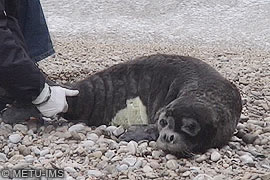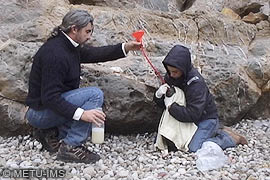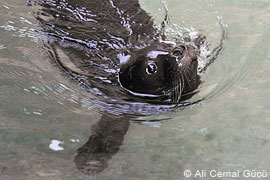Pup rescue in Samandag
Ali Cemal Gücü, Evrim Erbil, Meltem Ok, Serdar Sakinan and Billur Celebi
Middle East Technical University Institute of Marine Sciences has carried out monk seal research on the northeast corner of the Mediterranean Sea [see Perspectives TMG 6(2): December 2003]. The results of various surveys to the area indicated that the best sites for the seals are located very near to the Turkish-Syrian border. One of the main threats to the seal in this area was illegal fishing practices such as use of explosives. Then, the LEVANT Nature Conservation Society started a new project called Eco-Fish in the area [see Eco-fish, TMG 9(1): June 2006]. The new project unified the fishermen under a fisheries cooperative. Today, the fish, caught non-detrimentally by the members of the Meydan Fisheries cooperative, is being sold to the customers through the Internet. With this system the high commission paid to the fishmonger was diverted to the cooperative and the members doubled their income. The eco-fish project achieved its major goal and use of explosives has been reduced significantly. The project also aimed to establish amity between seal and the fishermen.
Early on 5 November 2006, following a storm, fishermen of the cooperative sighted a seal pup stranded on a beach near to their port. They immediately called the METU-IMS. An hour later a small team from the LEVANT Nature Conservation Society reached the area. A quick inspection showed that the pup was a female no older than 10 days and quite healthy apart from some scratches on the left flipper and the neck. After the examination, the area was abandoned immediately in order not to scare the mother in case she was around. Also, the crowd from the village who heard the story and came to see the seal, was kept away from the beach.
A part of the team watched the pup from a distance in a hide until afternoon. The pup wandered about along the beach and finally found shelter at the foot of a boulder, just on the edge of the swash zone.
In the meantime, the other part of the team tried to reach veterinary assistance. It was a weekend and due to the remoteness of the area the mobile phone was not functioning. Moreover, the electricity had been cut because of the storm. Finally, a seal veterinarian of the Rome Zoo was contacted who guided the team through further steps in the rescue operation. As the pup did not show symptoms of dehydration, the team decided to wait and observe her for 24 hours without taking any other action.
None of the fishermen had seen a seal recently; therefore it was a little surprising for them to find a newborn pup in the area. Luckily the coast had been surveyed by the METU-IMS team and all the caves had been explored and documented earlier. It was therefore possible to monitor the most probable breeding sites throughout the day to discover whether the mother was still around and looking for her pup.
Next day, in the morning, the sea was calmer, and the mother was sighted in a neighbouring bay in front of a cave. However, the health of the pup had worsened; her eyes were red and the scars on her body were susceptible to infection. Therefore, she was tube-fed with a solution of minced fish, rehydration salts and vitamins in the afternoon. The scars were cleaned with an antiseptic solution. After the treatment the beach was immediately abandoned again.
 |
|
 |
|
|
|
|
The fishermen who first sighted the pup had seen barking dogs around her, raising fears that her wounds might have been sustained during a dog attack. In the meantime, another team at the Institute contacted several veterinarians having wildlife experience in order to obtain further veterinary assistance in treating the wounds. Some of the veterinarians were cautious about an unnecessary use of antibiotics, which might possibly have jeopardized recognition of the pup by her mother. Therefore no antibiotics were applied but instead the body temperature of the seal was monitored regularly. Among the contacted veterinarians, Huseyin Cihan of the Uludag University Faculty of Veterinary Medicine, called attention to dog bites and possible infection by distemper virus that might have been carried by the dogs. He proposed vaccination against the virus. The medicine needed could not be found in the neighbouring cities and in the end was sent to the site by Dr. Cihan himself.
On the third day, the sea was very calm and with the first light the pup swam along the coast, but took the opposite direction to where her mother and breeding cave were. Finally, she returned to the same point on the same beach where she had slept the previous night.
The pup was named Ruzgar (the Wind) since she was brought with the wind. She was fed twice a day and left alone on the beach afterwards. The people kept away and a watch was always kept over her. Finally, on the fifth day, the pup met the mother and they returned to the cave. The cave was monitored, first visually by a team member and then with an infrared camera. After a very rapid recuperation period, she started to gain weight and moulted the lanugo. After two and a half months she left the cave and moved to another, 500 meter away. As of May 2007, Ruzgar is still in the area. She was also sighted on the Syrian side.
While cursed elsewhere due to the damage they inflict on fishing nets, the seals are considered as a sign of fertility in Meydan village. The fisherman considers himself privileged if Ruzgar feasts with the fish caught on his nets.
Lessons learnt
- We consider ourselves very lucky, because this event happened in an area that we had surveyed and mapped before. It was therefore possible to find the mother and remain patient until she came to take her pup. Under other circumstances, we might easily have grown discouraged and have transferred the pup to the Institute’s harbour for ex situ care and rehabilitation. Consequently, the pup would never have returned to the colony she belonged to. Therefore, mapping the distribution of the seals and their habitats is of crucial importance. Such information may be vital in determining whether the pup is abandoned or is simply lost.
- If a pup somehow gets lost, the mother keeps searching for it for a long time. This is a very important fact to be remembered before taking any action to isolate a pup in captivity for rehabilitation purposes.
- Treatment of a lost or even an abandoned pup is not only a veterinary case. While keeping the pup alive should have priority, the ultimate goal should be the ecological survival of the individual. Unless a pup is returned to its colony it can hardly be considered as a gain for survival of the species. Therefore, any pup rescue operation needs not only to be a veterinary concern but also requires ecological and biological consideration, since the species in question is on the verge of extinction.
- Scientists in the field working on Mediterranean monk seals are not necessarily veterinarians. Therefore an inventory of able and experienced seal veterinarians, who can provide expert help when required, is of utmost importance; possibly more so than a rehabilitation unit. Such a network needs to be prepared and continuously updated.
|







